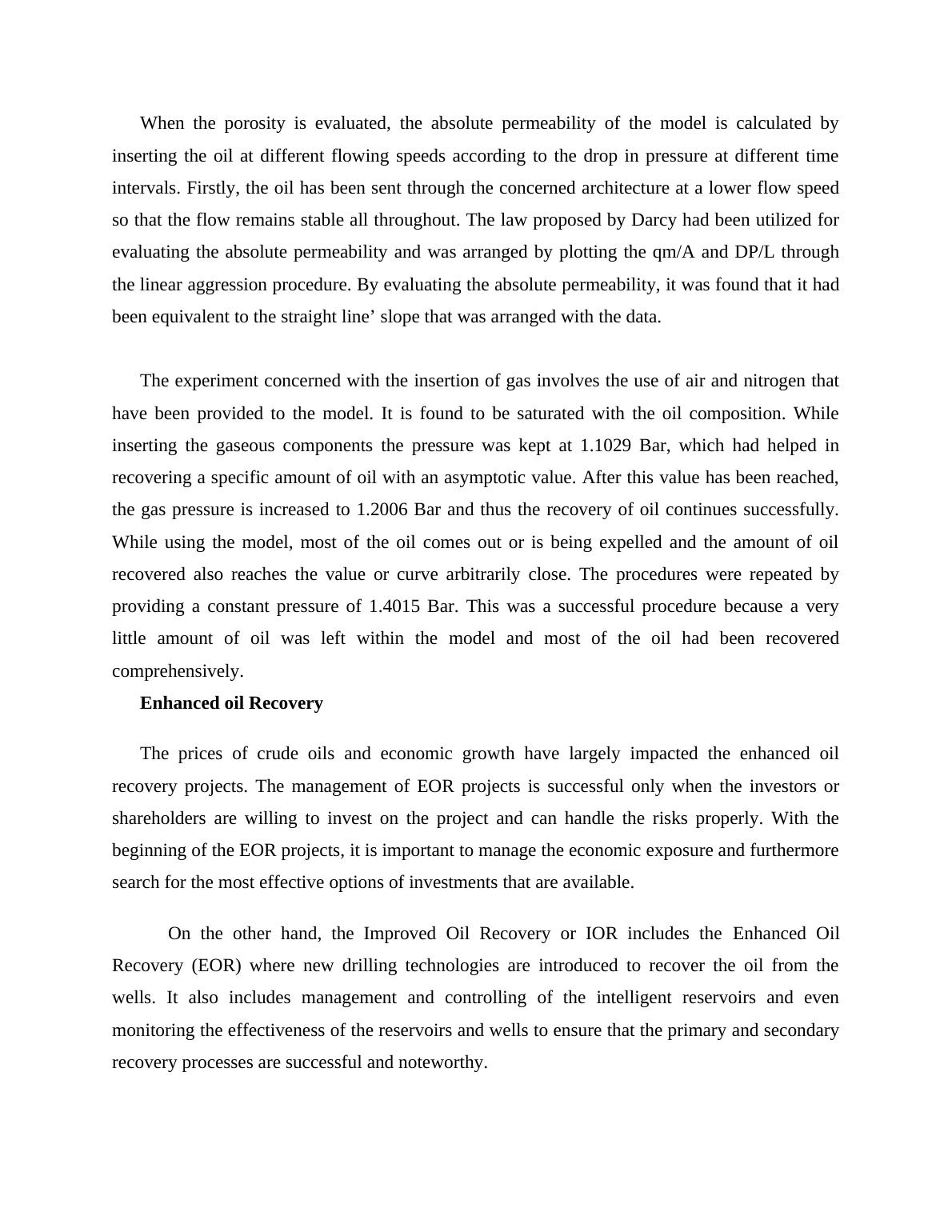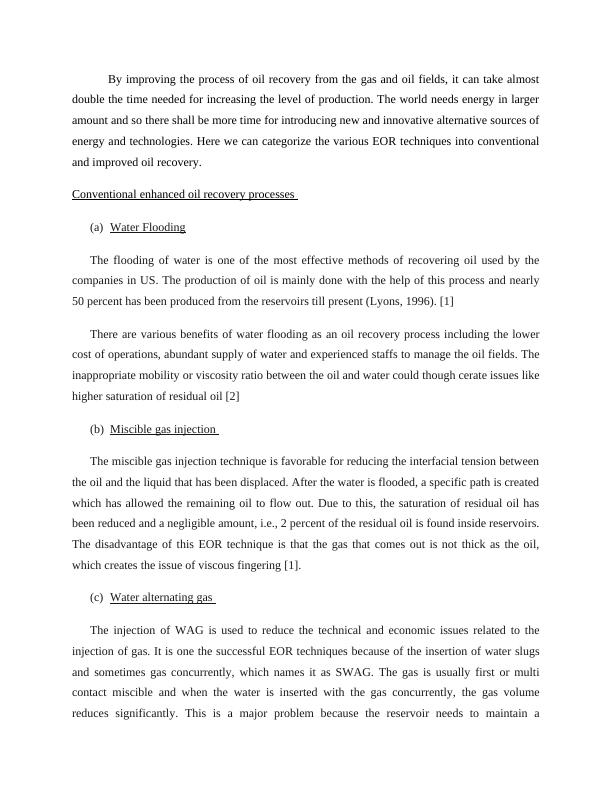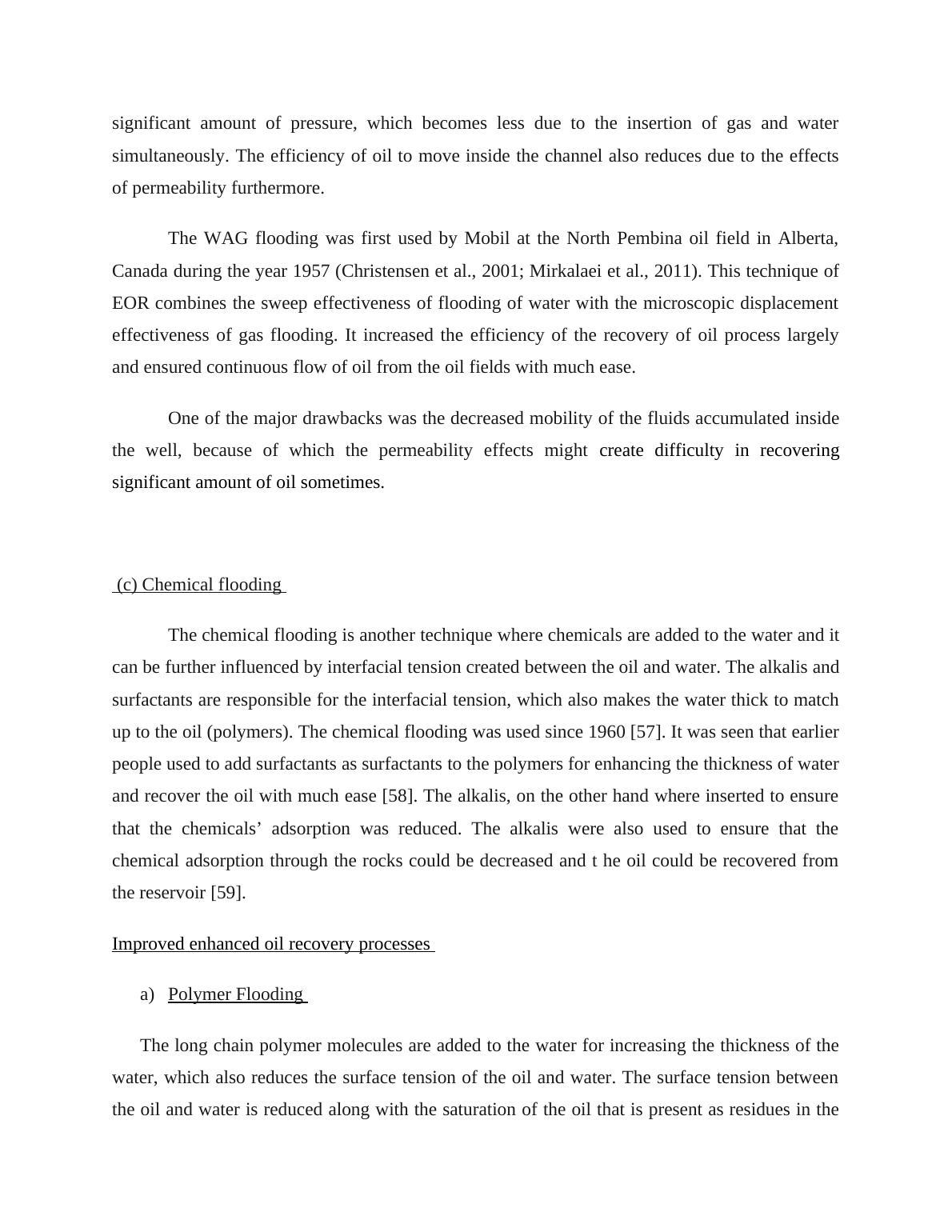(PDF) Porosity and Permeability
Added on 2021-04-24
9 Pages2980 Words121 Views
When the porosity is evaluated, the absolute permeability of the model is calculated byinserting the oil at different flowing speeds according to the drop in pressure at different timeintervals. Firstly, the oil has been sent through the concerned architecture at a lower flow speedso that the flow remains stable all throughout. The law proposed by Darcy had been utilized forevaluating the absolute permeability and was arranged by plotting the qm/A and DP/L throughthe linear aggression procedure. By evaluating the absolute permeability, it was found that it hadbeen equivalent to the straight line’ slope that was arranged with the data. The experiment concerned with the insertion of gas involves the use of air and nitrogen thathave been provided to the model. It is found to be saturated with the oil composition. Whileinserting the gaseous components the pressure was kept at 1.1029 Bar, which had helped inrecovering a specific amount of oil with an asymptotic value. After this value has been reached,the gas pressure is increased to 1.2006 Bar and thus the recovery of oil continues successfully.While using the model, most of the oil comes out or is being expelled and the amount of oilrecovered also reaches the value or curve arbitrarily close. The procedures were repeated byproviding a constant pressure of 1.4015 Bar. This was a successful procedure because a verylittle amount of oil was left within the model and most of the oil had been recoveredcomprehensively. Enhanced oil RecoveryThe prices of crude oils and economic growth have largely impacted the enhanced oilrecovery projects. The management of EOR projects is successful only when the investors orshareholders are willing to invest on the project and can handle the risks properly. With thebeginning of the EOR projects, it is important to manage the economic exposure and furthermoresearch for the most effective options of investments that are available. On the other hand, the Improved Oil Recovery or IOR includes theEnhanced OilRecovery (EOR) where new drilling technologies are introduced to recover the oil from thewells. It also includes management and controlling of the intelligent reservoirs and evenmonitoring the effectiveness of the reservoirs and wells to ensure that the primary and secondaryrecovery processes are successful and noteworthy.

By improving the process of oil recovery from the gas and oil fields, it can take almostdouble the time needed for increasing the level of production. The world needs energy in largeramount and so there shall be more time for introducing new and innovative alternative sources ofenergy and technologies. Here we can categorize the various EOR techniques into conventionaland improved oil recovery. Conventional enhanced oil recovery processes (a)Water FloodingThe flooding of water is one of the most effective methods of recovering oil used by thecompanies in US. The production of oil is mainly done with the help of this process and nearly50 percent has been produced from the reservoirs till present (Lyons, 1996). [1]There are various benefits of water flooding as an oil recovery process including the lowercost of operations, abundant supply of water and experienced staffs to manage the oil fields. Theinappropriate mobility or viscosity ratio between the oil and water could though cerate issues likehigher saturation of residual oil [2](b)Miscible gas injection The miscible gas injection technique is favorable for reducing the interfacial tension betweenthe oil and the liquid that has been displaced. After the water is flooded, a specific path is createdwhich has allowed the remaining oil to flow out. Due to this, the saturation of residual oil hasbeen reduced and a negligible amount, i.e., 2 percent of the residual oil is found inside reservoirs.The disadvantage of this EOR technique is that the gas that comes out is not thick as the oil,which creates the issue of viscous fingering [1]. (c)Water alternating gas The injection of WAG is used to reduce the technical and economic issues related to theinjection of gas. It is one the successful EOR techniques because of the insertion of water slugsand sometimes gas concurrently, which names it as SWAG. The gas is usually first or multicontact miscible and when the water is inserted with the gas concurrently, the gas volumereduces significantly. This is a major problem because the reservoir needs to maintain a

significant amount of pressure, which becomes less due to the insertion of gas and watersimultaneously. The efficiency of oil to move inside the channel also reduces due to the effectsof permeability furthermore. The WAG flooding was first used by Mobil at the North Pembina oil field in Alberta,Canada during the year 1957 (Christensen et al., 2001; Mirkalaei et al., 2011). This technique ofEOR combines the sweep effectiveness of flooding of water with the microscopic displacementeffectiveness of gas flooding. It increased the efficiency of the recovery of oil process largelyand ensured continuous flow of oil from the oil fields with much ease. One of the major drawbacks was the decreased mobility of the fluids accumulated insidethe well, because of which the permeability effects might create difficulty in recoveringsignificant amount of oil sometimes. (c) Chemical flooding The chemical flooding is another technique where chemicals are added to the water and itcan be further influenced by interfacial tension created between the oil and water. The alkalis andsurfactants are responsible for the interfacial tension, which also makes the water thick to matchup to the oil (polymers). The chemical flooding was used since 1960 [57]. It was seen that earlierpeople used to add surfactants as surfactants to the polymers for enhancing the thickness of waterand recover the oil with much ease [58]. The alkalis, on the other hand where inserted to ensurethat the chemicals’ adsorption was reduced. The alkalis were also used to ensure that thechemical adsorption through the rocks could be decreased and t he oil could be recovered fromthe reservoir [59]. Improved enhanced oil recovery processes a)Polymer Flooding The long chain polymer molecules are added to the water for increasing the thickness of thewater, which also reduces the surface tension of the oil and water. The surface tension betweenthe oil and water is reduced along with the saturation of the oil that is present as residues in the

End of preview
Want to access all the pages? Upload your documents or become a member.
Related Documents
Carbon Dioxide Enhanced Oil Recoverylg...
|23
|5233
|266
Enhanced Oil Recovery - PDFlg...
|8
|1896
|135
Foam Introduction: Properties, Advantages, and Previous Researchlg...
|5
|707
|63
Importance of Relative Permeability - PDFlg...
|3
|1173
|189
Carbon Dioxide Enhanced Oil Recoverylg...
|12
|2287
|21
Improving the Understanding of Matrix Acidizing and Acidizing Design in a Petroleum Welllg...
|61
|11865
|70
